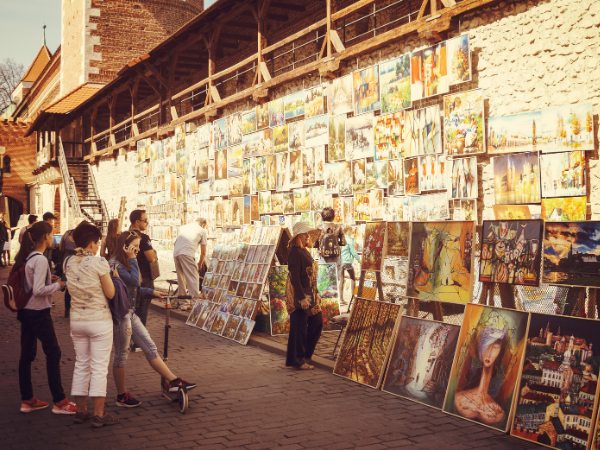“Icons, Innovation, and Infinite Imagination” is an exhibition showcasing the influential work of Andy Warhol. The exhibition features a diverse array of Warhol’s iconic pieces, highlighting his innovation and creativity.
From his famous celebrity portraits to his experimental film work, the exhibition offers a comprehensive look at Warhol’s boundless imagination and impact on art and culture. Warhol’s ability to transform everyday objects and people into symbols of modern society is a central theme of the exhibition.
Visitors can explore the evolution of Warhol’s artistic style and gain insight into his role as a pioneer of Pop Art. By delving into Warhol’s timeless relevance and enduring influence, “Icons, Innovation, and Infinite Imagination” provides a compelling exploration of the artist’s enduring legacy.
Early Life And Influences
Andy Warhol, an iconic figure in the art world, was known for his innovative techniques and boundless imagination. His early life shaped his influential career, cementing his status as a pioneer in pop art.
Family Background
Born Andrew Warhola on August 6, 1928, in Pittsburgh, Pennsylvania, Warhol hailed from a working-class immigrant family. His parents, Andrej and Julia Warhola, were both immigrants from Mikó, a small village in present-day Slovakia. Coming from a humble background, Warhol’s family instilled in him the values of hard work, perseverance, and the pursuit of the American dream.
Artistic Influences
Warhol’s love for art began at a young age, influenced by his mother, Julia, who was herself an artist. She nurtured his creative spirit and provided him with his first art lessons. Warhol’s keen interest in popular culture and comic books further shaped his artistic sensibilities. This early exposure to mass media imagery and narrative techniques would come to define Warhol’s signature style later on.
In addition to his family’s influence, Warhol drew inspiration from various artistic movements and artists. The precision and detail of Renaissance art, the boldness of Pop Art, and the experimental nature of the avant-garde all left a lasting impact on Warhol’s artistic journey. He admired the pop culture icons and consumer goods celebrated by artists such as Jasper Johns and Robert Rauschenberg. These influences, together with his own unique vision, ultimately led to the birth of his iconic style.
Warhol’s early life and influences shaped him into the innovative artist he would become. From his humble upbringing to the creative guidance provided by his mother and the inspiration derived from various art movements, Warhol’s journey as an artist was set in motion. His ability to merge high art and popular culture would go on to make him an iconic figure in the art world, forever changing the landscape of contemporary art.

Pop Art And Iconic Works
Andy Warhol, the legendary artist and one of the leading figures of the Pop Art movement, is revered for his imagination and innovation. His ability to transform everyday objects and celebrities into iconic works of art sparked a new wave of creativity in the art world. In this section, we will delve into the world of Pop Art and explore some of Warhol’s most famous and significant works.
Defining Pop Art
Pop Art emerged in the 1950s and reached its zenith in the 1960s, challenging the traditional boundaries of art and challenging conventional notions of taste and beauty. It celebrated mass production and consumer culture, drawing inspiration from popular and commercial imagery found in advertisements, comic books, and consumer products. By incorporating such elements into their artwork, artists like Warhol sought to blur the line between high and low culture. With their vibrant colors, bold lines, and repetitive patterns, Pop Art pieces were a departure from the somber tones and subject matters prevalent in traditional art. They embraced playfulness, irony, and a sense of accessibility, making art more relatable to everyday life.
Famous Works
Warhol’s vast body of work includes numerous iconic pieces that have left an indelible mark on the art world. Let’s take a closer look at some of his most renowned creations:
- Campbell’s Soup Cans (1962): A series of paintings depicting the iconic Campbell’s soup cans, this work solidified Warhol’s status as a Pop Art pioneer. Its repetitive composition and focus on commercial subject matter challenged the traditional notions of what could be considered art.
- Marilyn Diptych (1962): This striking artwork, depicting Marilyn Monroe, showcases Warhol’s exploration of celebrity culture. Through the use of vibrant colors and repeated images, he captures the transient nature of fame and the idea of fame as a commodity.
- Brillo Boxes (1964): This installation piece recreated Brillo soap pad boxes, blurring the line between art and everyday objects. By elevating a mundane item to the status of art, Warhol challenged traditional notions of artistic value and questioned the concept of originality.
- Elvis Presley (1963) and Mao Zedong (1972): These portraits of Elvis Presley and Mao Zedong epitomize Warhol’s fascination with celebrity and political power. Through their repetition and stylized depiction, he seeks to explore society’s obsession with icons and the power they hold over popular culture.
These are just a few examples of Warhol’s revolutionary works that continue to captivate audiences today. Through his creative vision and unbounded imagination, Warhol reshaped the art landscape and left an enduring legacy that continues to inspire generations of artists.
Innovation And Collaboration
Andy Warhol, a renowned artist and cultural icon, was not only known for his unique style and bold works of art but also for his innovation and collaborations. He consistently pushed the boundaries of art by exploring new media, engaging in collaborations, and bringing his infinite imagination to life on various platforms.
Exploration Of Media
Warhol’s artistic journey was characterized by his exploration of different media and techniques. From his iconic pop art paintings to experimental films, he embraced various forms of expression. Warhol was fascinated by technology, and this curiosity led him to redefine what art could be.
- He experimented with screen printing, a technique that allowed him to produce multiple copies of his artwork quickly and efficiently.
- Warhol also ventured into non-traditional art forms, such as creating multimedia installations and performance art.
Collaborations
Warhol’s innovative spirit extended to the realm of collaborations, where he embraced the power of shared creativity. He believed that collaborating with others could result in unique and groundbreaking outcomes. Throughout his career, Warhol collaborated with various individuals who shared his passion for innovation and art.
| One of his most famous collaborations was with the rock band, The Velvet Underground. Together, they created the iconic album cover for “The Velvet Underground & Nico”. |
| Warhol also collaborated with other artists, such as Jean-Michel Basquiat, Keith Haring, and Jean Paul Gaultier, to create mesmerizing works of art that merged their distinct styles. |
Impact On Art And Culture
Andy Warhol was an artist whose impact on art and culture cannot be overstated. Through his innovative approach and infinite imagination, Warhol left an indelible mark on the art world, forever changing the way we perceive art and its intersection with popular culture.
Legacy In Contemporary Art
Warhol’s influence continues to reverberate throughout contemporary art. His iconic pop art style, characterized by vibrant colors and repetitive motifs, has inspired countless artists to rethink traditional artistic boundaries. His use of everyday objects and celebrities as subjects has prompted a shift in the perception of what can be considered art, paving the way for new forms of expression and interpretation.
Cultural Influence
Warhol’s impact extends beyond the realm of art, permeating popular culture in profound ways. His exploration of fame, consumerism, and celebrity culture has become ingrained in our societal consciousness, shaping the way we perceive and interact with media, advertising, and celebrity icons. The ubiquitous nature of his art has made him a cultural phenomenon, continuously referenced and reinterpreted in music, fashion, and film.
Eternal Imagination And Enduring Legacy
Andy Warhol, the iconic figure in the world of art, showcased an eternal imagination and left an enduring legacy that continues to influence modern creativity.
Influence On Modern Creativity
Warhol’s innovative approach to artistry transcended traditional boundaries, inspiring generations of modern creatives to push the limits of their own imaginations.
Everlasting Impact
- Warhol’s pioneering techniques and unique perspective have left an everlasting impact on art, pop culture, and beyond.
- His ability to merge art with popular culture has set a precedent for contemporary artists to follow, blurring the lines between high and low culture.
Conclusion
Andy Warhol’s artistic legacy is truly unparalleled. His ability to transform everyday objects and celebrities into iconic works of art has left an indelible mark on the art world. Through his innovative techniques and imaginative vision, Warhol opened up new possibilities for artistic expression.
His work continues to inspire and captivate audiences to this day. From his pop art prints to his exploration of media and consumerism, Warhol’s art serves as a reminder of the infinite potential of creativity and the power of thinking differently.
Discovering the world through Warhol’s lens is a journey worth taking.




